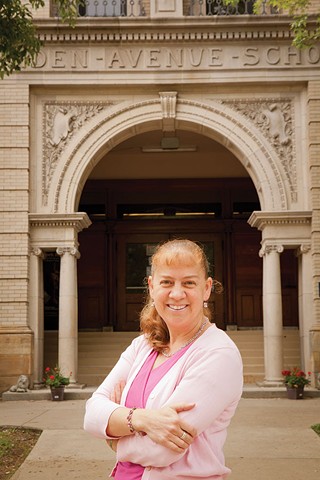At a time when most of the news coming out of the Pittsburgh Public Schools involves cutting services and closing schools, one coalition is pushing to expand district services, and keep schools open.
Local activists are pushing a "community schools" model, which opens school buildings up to house social services used by children and their families — all under one roof.
"It's really about changing our collective mindset around what public schools are and should be," says Jessie Ramey of Great Public Schools Pittsburgh, a coalition comprised of community groups and the Pittsburgh Federation of Teachers. "We have to shift our way of thinking, so that we collectively embrace our public schools as community assets. ... Schools should only close if there are no children to go to them."
Still, the district says the proposal comes with hidden costs — and officials caution against viewing the proposal as a way to prevent school closings in the short term.
Community schools became popular in the 1990s as a way of addressing problems associated with poverty. Today, according to the Coalition for Community Schools, a national organization, there are approximately 5,000 community schools in cities across the country, providing "wraparound services" such as after-school programs for students whose parents work late, and on-site health care for students whose parents can't take them to the doctor. Schools can also partner with community organizations that provide art and music programming.
Programs are paid for through public and private funding, including foundation support and federal grants. Some organizations offer their services free of charge. For districts, Ramey says, the principal cost is hiring a community-schools coordinator to solicit funding and build partnerships with service providers. Ramey also recommends having $50,000 in funding to help with other start-up costs.
"The community vision is to reduce class sizes and restore lost programs, such as music [and] art," Ramey says.
But before that can happen, district officials will have to do the math.
Although city-schools Superintendent Linda Lane supports the community-school concept, she says implementing it would have additional costs. For security reasons, school buildings would have to be retrofitted, so students would be insulated from outsiders using the services.
"There are some things that need to be figured out," says Lane, who is waiting for the community to present a plan the district can discuss with them.
Lane says she couldn't estimate the potential impact on the $459 million city-schools budget. But such costs have been an issue in districts where community schools have been implemented. Schools in Hartford, Conn., for example, were obliged to cover some maintenance and security costs. "In some schools," the district noted in a progress report, "this has been an issue for principals who are required to staff the facility in the after-school hours."
Almost any cost might be difficult for the district to swallow. City schools are facing a $37.5 million deficit in 2015, and the district projects that each school it closes will save between $500,000 and $1 million yearly. Officials are pondering the closure of between five and 10 district schools, and Lane says that because community schools take time to implement, the approach is unlikely to spare those programs.
"Nobody has really laid out what the next steps are," says Lane. "But if we have a plan that we have community support for ... and they have a plan for how to finance it, I'd absolutely support it."
Pittsburgh Federation of Teachers President Nina Esposito-Visgitis says preventing school closings is only one of many reasons to support the model.
"I've followed the community-schools model for years, and I've tried to talk to the district about it for years," Esposito-Visgitis says. "It helps teachers; it takes away a lot of problems and makes education and learning a priority. I can't tell you how many teachers have offered to have their schools be a pilot."
Some parents don't have the knowledge or time needed to take advantage of the social services that are available, Esposito-Visgitis says. Putting these services in schools, instead of having them scattered throughout the community, makes them easier for parents to access.
"I understand money is a true issue, but I don't think we should use that as a reason not to do it," Esposito-Visgitis says. "I don't want us to talk too long. What I would really love to talk to a few possible funders and get it started in one of our schools."
Two months ago, members of the teachers' union, school-board members and other officials attended a conference in Cincinnati, to get a closer look at the community-schools approach.
"I think the nicest surprise I found is absenteeism tends to be down, graduation rates tend to go up [at community schools]," said Carolyn Klug, the school-board representative for District 9.
Student often miss school as a result of physical- or mental-health problems, but Klug says chronic absenteeism can be reduced by addressing these problems in school.
According to the Cincinnati school district, students receiving any opportunity or support service — including tutoring or after-school activities — saw an average 5.6 percent increase in their reading scores between the 2009-2010 and 2010-2011 school years, and a 4.6 percent advance in math. Students who did not receive these services saw only a 2 percent gain in reading and a 1.8 percent improvement in math.
The Cincinnati event was hosted by the Coalition for Community Schools, a national alliance affiliated with the Institute for Educational Leadership, a nonpartisan organization funded by a variety of national foundations. The gathering drew an estimated 1,400 participants from school districts around the country, many of which are also facing budget cuts.
"I'm aware of the budgetary challenges in public schools ... but there are still ways," says CCS Executive Director Martin Blank.
Districts are utilizing the business community, health systems, local government, community nonprofits and other agencies to expand opportunities for students. In Philadelphia, for example, the United Way and other foundations came together to provide funding to hire a community-schools coordinator to work in the schools. In other cities, local governments help provide funding.
"It's the school system's space," Blank says, "but they figured out a funding source independent of the school system."
And the diversity of support for community schools, he says, is a testament to its effectiveness.
"The strategy is growing across the country," says Blank. "It's in all parts of America, whether they're red or blue; whether they're serving the black, Latino or white populations."
Community schooling isn't a completely new idea in Pittsburgh. The Homewood Children's Village, a local nonprofit organization, has been providing wraparound services to students at Faison K-5, Lincoln K-5, University Prep 6-12 and Westinghouse 6-12.
The nonprofit "has reached out to our partners in the community to really bring to bear the services that are necessary for our kids to develop," says HCV President Derrick Lopez. "It's important for us to leverage the time we have with kids, and we've made it easier for parents to access the services their families need."
While not a school itself, HCV provides programs similar to those found in community schools, such as transportation and a weekend nutrition program. The nonprofit utilizes relationships with community organizations including: the YWCA, which provides after-school programs; the University of Pittsburgh, whose volunteers tutor and mentor students; and foundations, which provide needed funding.
"This is incredibly difficult work," says Lopez. HCV, he notes, spent several years planning and soliciting community contributions before implementing the model. Success, he says, is "based on relationship-building. We build upon the model every year. It can be done on a large scale, but it has to be done incrementally."
At least one potential community partner is already on board.
"I love the idea" of community schools, says Mayor Bill Peduto. By housing community services, "we can provide a source of revenue to keep the schools open, and provide a foundation to attract people to the neighborhood."
Peduto, who convened a task force on public schools earlier this year, says the community-school approach will be on the agenda. The task force, he says, should release a report on the district's future around Labor Day.
Peduto acknowledges the district's concerns about costs, and says the city could help find resources to cover them. "I'm not trying to place an unfunded mandate on Dr. Lane," he says. "I want to work with her."
"We don't need to close more schools," Peduto adds. "We need to find ways to keep them open."















